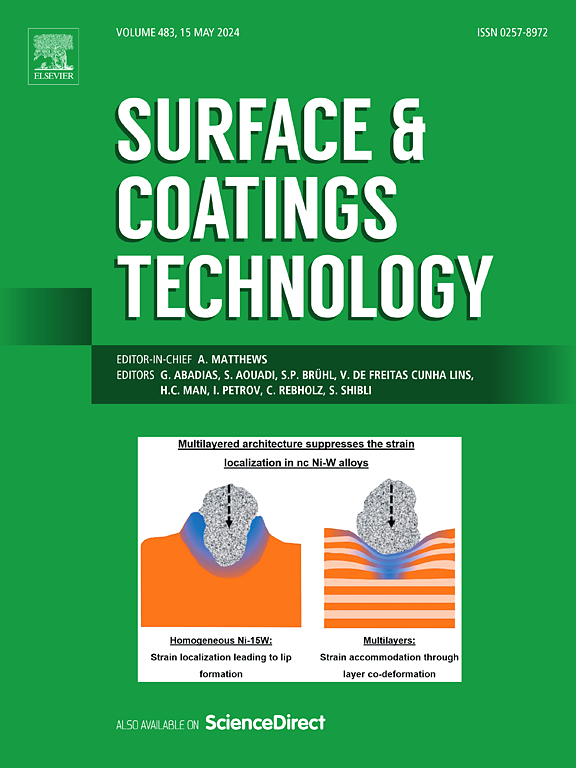Exploring the microstructure and wear-resistance of Fe-Cr-C-W arc cladding coatings by laser remelting
IF 5.3
2区 材料科学
Q1 MATERIALS SCIENCE, COATINGS & FILMS
引用次数: 0
Abstract
In this study, Fe-Cr-C-W cladding coatings were fabricated by arc cladding (AC) and subsequently post-treated through laser remelting (LR). The microstructure was characterized using optical metallography (OM), scanning electron microscopy (SEM), and X-ray diffraction (XRD). The wear resistance was assessed using microhardness tests and a ring-disc tribometer under loads of 300, 400, and 500 N at room temperature (RT) and 200 °C. The impact of LR on the microstructure and wear resistance of the Fe-Cr-C-W cladding coatings was investigated. The results indicate that the two fused cladding coatings predominantly consist of martensite, M7C3 and M23C6 phases. LR refined the grains of the cladding coating, reducing the average dendrite size from 6.34 μm to 4.63 μm, decreasing porosity, and increasing microhardness by 16 % to 858 HV0.5. At elevated temperatures (200 °C), the average coefficient of friction (COF) for LR-treated coating decreases to 0.115 under a load of 500 N, attributed to the formation of oxide layer and the generation of tempered martensite. At RT, the primary wear mechanism was abrasive wear. At elevated temperatures, adhesive wear intensified and was accompanied by oxidative wear. Furthermore, the LR-treated coating demonstrated a more stable COF and a lower wear rate at 200 °C/500 N, enhancing its suitability for high-temperature and high-load applications. The unique synergy between tempered martensite and oxide film in the Fe-Cr-C-W cladding coatings at 200 °C significantly reduced the COF to 0.115.
激光重熔Fe-Cr-C-W电弧熔覆层的显微组织和耐磨性研究
本研究采用电弧熔覆(AC)法制备Fe-Cr-C-W熔覆涂层,并进行激光重熔(LR)后处理。采用光学金相(OM)、扫描电镜(SEM)和x射线衍射(XRD)对其微观结构进行了表征。在室温(RT)和200°C下,使用显微硬度测试和环盘摩擦计评估了300、400和500 N载荷下的耐磨性。研究了LR对Fe-Cr-C-W熔覆层组织和耐磨性的影响。结果表明,两种熔覆层主要由马氏体、M7C3和M23C6相组成。LR细化了熔覆层的晶粒,使平均枝晶尺寸从6.34 μm减小到4.63 μm,孔隙率降低,显微硬度提高16%,达到858 HV0.5。在高温(200℃)下,500n载荷下,lr处理涂层的平均摩擦系数(COF)降至0.115,主要原因是氧化层的形成和回火马氏体的生成。在RT中,主要的磨损机制是磨料磨损。在高温下,粘结磨损加剧,并伴有氧化磨损。此外,经过lr处理的涂层在200°C/500 N时表现出更稳定的COF和更低的磨损率,增强了其在高温和高负荷应用中的适用性。在200℃时,Fe-Cr-C-W熔覆层中回火马氏体和氧化膜之间的独特协同作用使COF显著降低至0.115。
本文章由计算机程序翻译,如有差异,请以英文原文为准。
求助全文
约1分钟内获得全文
求助全文
来源期刊

Surface & Coatings Technology
工程技术-材料科学:膜
CiteScore
10.00
自引率
11.10%
发文量
921
审稿时长
19 days
期刊介绍:
Surface and Coatings Technology is an international archival journal publishing scientific papers on significant developments in surface and interface engineering to modify and improve the surface properties of materials for protection in demanding contact conditions or aggressive environments, or for enhanced functional performance. Contributions range from original scientific articles concerned with fundamental and applied aspects of research or direct applications of metallic, inorganic, organic and composite coatings, to invited reviews of current technology in specific areas. Papers submitted to this journal are expected to be in line with the following aspects in processes, and properties/performance:
A. Processes: Physical and chemical vapour deposition techniques, thermal and plasma spraying, surface modification by directed energy techniques such as ion, electron and laser beams, thermo-chemical treatment, wet chemical and electrochemical processes such as plating, sol-gel coating, anodization, plasma electrolytic oxidation, etc., but excluding painting.
B. Properties/performance: friction performance, wear resistance (e.g., abrasion, erosion, fretting, etc), corrosion and oxidation resistance, thermal protection, diffusion resistance, hydrophilicity/hydrophobicity, and properties relevant to smart materials behaviour and enhanced multifunctional performance for environmental, energy and medical applications, but excluding device aspects.
 求助内容:
求助内容: 应助结果提醒方式:
应助结果提醒方式:


